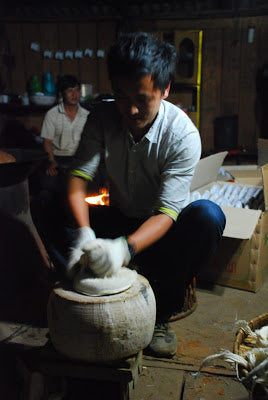There are two tea producing centers called Mengsong, one near Nannuo, and the other on Da Menglong mountain to the south east of Bulang mountain, right on the Burmese border. We visited the latter, which could very easily have become part of Burma, except the People's Liberation Army garrisoned the mountain to guard against Nationalist Chinese forces who had retreated into Burma. There were still border clashes here up to 1976. We were here to see Korean puer producer Chong Kyongwon, and the Hani host family who help process his tea.
As you can see from the photo below, the trees in Da MengLong are huge, and grow on a steep slope. Climbing in and out of the thicket of branches to get to the fresh buds is not easy. Even an experienced picker can take the whole day to harvest just 3 trees, yielding 10kg of fresh leaves.

Picking tea high in the trees, above the clouds
Above photo taken by Chong Kyongwon - one of many great shots you can find on his naver blog site. Not an easy site to navigate if you can't read Korean, but once you click into an article, the menu on the left hand side allows you to browse his older posts.

Crickets in the tea leaves
Leaves will get crushed & stifled if left in the pickers basket all day, so those leaves picked in the morning are laid out on a plastic mat to wither. The warm, damp blanket of leaves attracts crickets & other insects, that have to be picked out before wok frying.

Epiphytes growing on the tea trees, look like dragonfly wings
I always find it comforting to find other plants growing on the tea trees. But the farmers pick these off, as they believe too many parasites sap the tea's strength.

Tightly bound puer cannonballs
In the darkness of a Hani family's living room, we took turns to steam & press maocha into bings. In the photo below the girl in the white T-shirt is doing the job of weigh & steam. She then passes the tin steamer can to the bag & shape technician, who has to quickly press the steamed leaves into a tight disc shape, and whip the loose end of the cloth bag into a tight knot.

Steaming & pressing puer bings

Pat the leaves down & knot the bag
Holding the center of the bag tight with your left hand, you use the base of your fist to flatten the leaves, rotating the disc quickly with the right hand so all sides get evenly pressed. The open end of the bag tapers to a long tail that needs to be wrapped into a coil at the center of the bing. If the cloth bag is not shaped & tied tightly enough, the bing will end up oval shaped instead of round. Maybe he's just being kind, but Chong Ge says his customers don't mind an oval bing, as this imperfection is proof it was hand-made!

Shaped & ready for pressing!

Foreign labour "press-ganged"
It's not often you get to see a Korean and an American making puer together! Kneeling on the stone press, one's whole body weight is used to tightly compress the tea cake. The pressed cake is put outside to dry, whilst still in the cloth bag. After an hour, the bing should be dry enough to peel off the bag without disturbing the leaves.

Freshly pressed cakes drying in the shade
These cakes are made from fat, bitter, buds collected from wild tea trees in DaXueShan and AiLaoShan. Chong Ge believes shade drying is better than drying in direct sunlight. He says direct sunlight is too hot, and only dries the outside of the bing, causing the center to develop mould. Shade drying allows osmosis to draw the moisture out of the center of the bing.

Bamboo shoots & fried tea leaves for dinner

